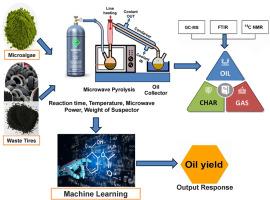利用集成机器学习预测微藻(螺旋藻)/轮胎共热解对生物燃料生产的协同效应
IF 6.2
2区 工程技术
Q2 ENERGY & FUELS
引用次数: 0
摘要
研究了在催化剂重量、微波功率和感受器数量等不同参数下,微藻与废轮胎微波辅助催化共热解(MACCP)的协同效应。优化后的反应条件可获得高质量的生物油,最大收率为50.46 wt%,水含量低,微波能耗从810降低到540 kJ。WT和微藻的共热解增强了脱氮和脱氧,提高了所得生物油的质量。生物油的气相色谱-质谱(GC-MS)分析发现,单芳烃和多芳烃的复杂组成增加,含氧化合物减少。采用集成机器学习方法来建模和预测结果,实现R2值在0.7到0.98之间。预测精度最高的模型是Extreme Gradient Boosting (XGB)和Extra Trees (ET),两者的R2均达到0.98。使用留一交叉验证技术对模型进行了严格验证,通过对除一个观测外的所有观测进行迭代训练并对被排除的数据点进行测试,确保了预测的鲁棒性和最小偏差。这项工作强调了微藻和WT共热解在可持续、低能耗的高质量生物油生产中的可能应用。这表明机器学习可以优化MACCP程序。本文章由计算机程序翻译,如有差异,请以英文原文为准。

Predicting synergistic effects on biofuel production from microalgae (Spirulina)/Tire Co-pyrolysis using ensemble machine learning
This study investigates the synergistic effects of microwave-assisted catalytic co-pyrolysis (MACCP) of microalgae and waste tires (WT) under varying parameters such as catalyst weight, microwave power, and susceptor quantity. Optimal reaction conditions yielded a high-quality bio-oil with a maximum yield of 50.46 wt% with low water content, significantly reducing microwave energy consumption from 810 to 540 kJ. The co-pyrolysis of WT and microalgae enhanced denitrogenation and deoxygenation, improving the quality of the resulting bio-oil. Gas chromatography-mass spectrometry (GC-MS) analysis of bio-oil identified an increase in the complex composition of mono- and polyaromatic hydrocarbons and a decrease in oxygenated compounds. An ensemble machine learning approach has been employed to model and predict outcomes, achieving R2 values between 0.7 and 0.98. The models with the best predicted accuracy were Extreme Gradient Boosting (XGB) and Extra Trees (ET), both of which achieved an R2 of 0.98. The models were rigorously validated using the Leave-One-Out Cross-Validation technique, ensuring robust predictions with minimal bias by training on all but one observation iteratively and testing on the excluded data point. The work highlights the possible use of co-pyrolyzing microalgae and WT for sustainable, high-quality bio-oil production with lower energy consumption. It shows that machine learning can optimize MACCP procedures.
求助全文
通过发布文献求助,成功后即可免费获取论文全文。
去求助
来源期刊

Journal of The Energy Institute
工程技术-能源与燃料
CiteScore
10.60
自引率
5.30%
发文量
166
审稿时长
16 days
期刊介绍:
The Journal of the Energy Institute provides peer reviewed coverage of original high quality research on energy, engineering and technology.The coverage is broad and the main areas of interest include:
Combustion engineering and associated technologies; process heating; power generation; engines and propulsion; emissions and environmental pollution control; clean coal technologies; carbon abatement technologies
Emissions and environmental pollution control; safety and hazards;
Clean coal technologies; carbon abatement technologies, including carbon capture and storage, CCS;
Petroleum engineering and fuel quality, including storage and transport
Alternative energy sources; biomass utilisation and biomass conversion technologies; energy from waste, incineration and recycling
Energy conversion, energy recovery and energy efficiency; space heating, fuel cells, heat pumps and cooling systems
Energy storage
The journal''s coverage reflects changes in energy technology that result from the transition to more efficient energy production and end use together with reduced carbon emission.
 求助内容:
求助内容: 应助结果提醒方式:
应助结果提醒方式:


